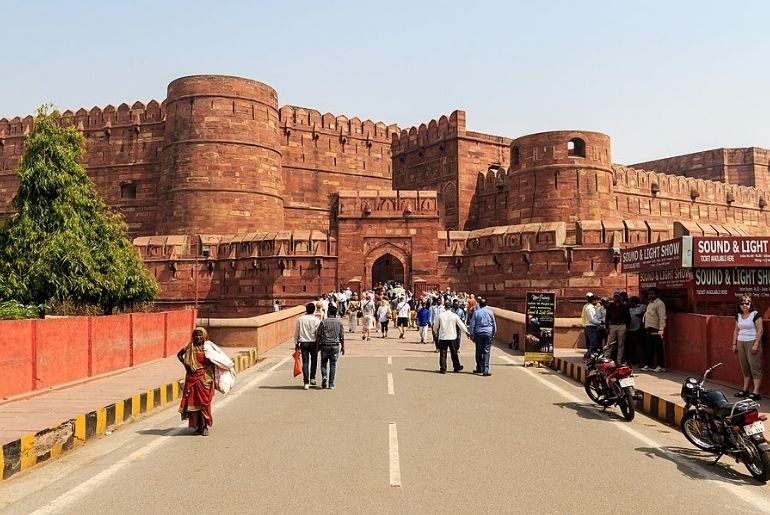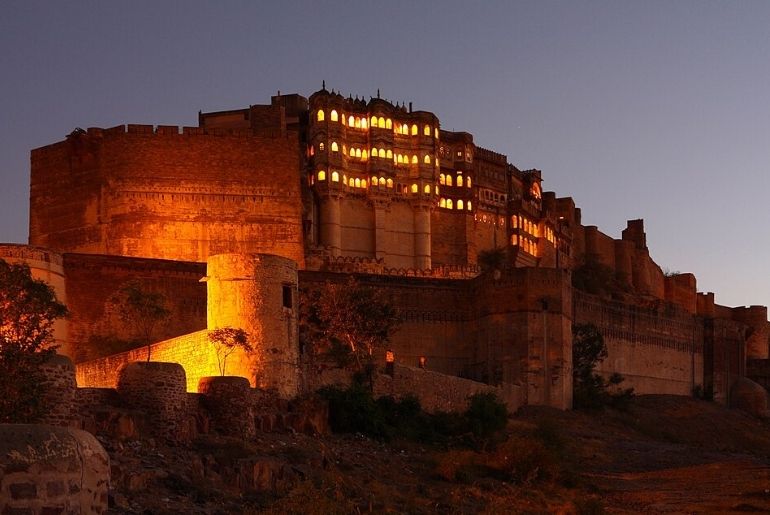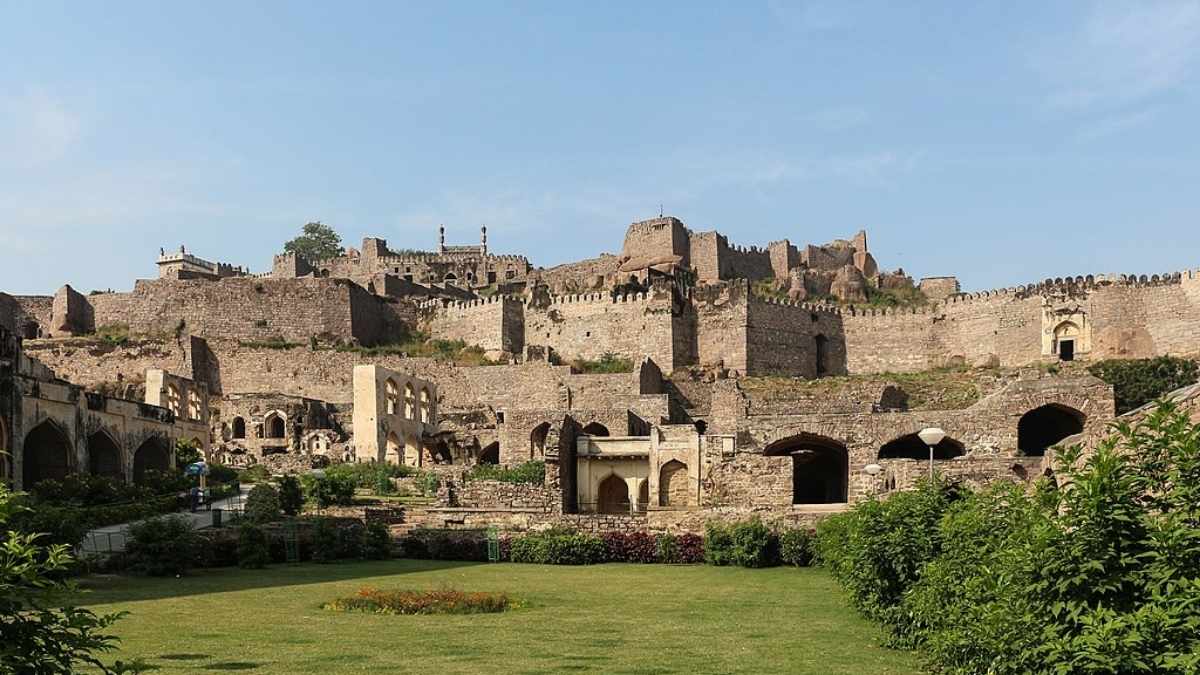We all have read about the forts in India and how each structure has a story to tell. These forts will not only amaze you with their architectural beauty, but they will also engage you in the silent tales of bravery, love, and tragedy from the past. If you’ve only read about various forts in history textbooks, then you’re missing out on the majestic beauty of India. To ensure that no one misses out on these historic beauties, we’ve curated a list of UNESCO forts in India where you can dive into the bygone era and learn about their grand architecture and ancient history.
List Of Must-Visit UNESCO Forts In India
1. Amer Fort, Rajasthan
Once home to the Rajput Maharajas, Amer Fort is one of the major tourist attractions in Rajasthan and a designated UNESCO World Heritage Site, along with five other forts of the region. Also known as Amber Fort or Amer Ka Kila, it is located just 11 km from Jaipur. Overlooking the scenic Moata Lake, the fort is a stunning example of Rajput and Mughal architecture, built entirely of red sandstone and marble. Its grand courtyards, impressive gates, and the exquisite Sheesh Mahal add to its timeless charm. Visitors can enhance their experience with an elephant ride or by attending the captivating light and sound show in the evening.
2. Chittorgarh Fort, Rajasthan
Spread across 700 acres, Chittorgarh Fort in Rajasthan is one of the largest forts in India. It has a rich history and is mentioned in many legendary battle tales. The fort complex includes 17 temples, 4 palaces, and 20 large water bodies. Fascinating, isn’t it? Built in the 7th century by Chitrangada Mori of the Maurya dynasty, the fort witnessed several epic events, including Alauddin Khilji’s siege. Major attractions include the iconic Vijay Stambh and Rani Padmini’s Palace. Chittorgarh Fort stands as a symbol of bravery and sacrifice and is a must-visit UNESCO fort in India.
3. Red Fort, Delhi

Built by the Mughal emperor Shah Jahan, this majestic fort became his residence after he moved his court from Agra to Delhi. The fort features two magnificent halls, Diwan-e-Khas and Diwan-e-Aam, and the Lahori Gate is one of its major attractions. Located in the heart of the city, the Red Fort remains one of India’s top historical landmarks. The fort even played a pivotal role during the freedom struggle and serves as the site for the annual Independence Day celebrations. Its architectural charm is enhanced by its red sandstone walls and beautifully enclosed gardens. Listed as a UNESCO fort in India, it is a must-visit destination in the city.
4. Fatehpur Sikri, Uttar Pradesh
With its rich architectural and historical significance, Fatehpur Sikri is another UNESCO fort in India that you can’t miss. As soon as you step in, you will be taken by the royal grandeur of the Mughal era that this fort exhibits with its luxurious palaces, courtyards, concert halls, and more. The Buland Darwaza here is intricately carved with several verses from the Holy Quran. The site includes multiple complexes, each offering a unique experience worth exploring. ‘Aankh Micholi’ is one of the famous spots within the complex, where Emperor Akbar is said to have played hide and seek with his wives. The bustling bazaar, once dedicated to the queens, still exists outside the fort, adding a memorable shopping experience to your visit.
5. Kumbhalgarh Fort, Rajasthan
If you wish to enjoy a panoramic view from the Aravalli Hills, Kumbhalgarh Fort is the place for you. This fort in Rajasthan is known for its massive walls that stretch around 36 km, making it the second-largest wall in the world, after the Great Wall of China. Surrounded by lush greenery, the fort’s architecture offers a glimpse into the Mewar dynasty and was constructed in the 15th century by the great Rana Kumbha. It is also the birthplace of Maharana Pratap. Built smartly and strategically to prevent enemy invasions, the fort features hidden passageways, secret chambers, and seven fortified gates to withstand attacks. This place is a must-visit to explore the remarkable construction and stories of the great kings of the past. Nature enthusiasts can also explore the Kumbhalgarh Wildlife Sanctuary. The fort lights up beautifully during festivals like the Mewar Festival, Shivaratri, and the Kumbhalgarh Festival.
6. Agra Fort, Uttar Pradesh

When you hear Agra, the Taj Mahal instantly comes to mind. Interestingly, you can view the Taj Mahal from this striking red sandstone fort, built in the 16th century by Emperor Akbar. The fort features majestic palaces, mosques, and courtyards, including Jahangir Mahal, Musamman Burj, and Sheesh Mahal. Agra Fort blends Mughal and Persian architectural styles, with some walls adorned in intricate mirror work, earning its place as a UNESCO fort in India. The fort has many historical tales related to Shah Jahan, Akbar, and Aurangzeb. It has also served as a backdrop in Bollywood films like Jodhaa Akbar and Mere Brother Ki Dulhan.
7. Golconda Fort, Hyderabad
Located just 9 km from Hussain Sagar Lake in Hyderabad, Golconda Fort offers stunning views of the city. Originally built as a mud structure by the Kakatiya dynasty in the 13th century, it was later taken over by the Bahmani Sultanate and the Qutb Shahi dynasty. The fort is famous for its remarkable acoustics; clapping near the dome entrance produces echoes that can be heard almost a kilometre away at a pavilion on a hill. The Fateh Darwaza is a highlight that draws every visitor’s attention. This exquisite fort combines Islamic and Hindu architectural styles. Exploring its mosques, palaces, and grand halls takes you on a fascinating journey that no history book can narrate.
8. Mehrangarh Fort, Rajasthan

Among the Hill Forts of Rajasthan, Mehrangarh Fort was one of the five forts added to the UNESCO list. Built in 1459 by Rao Jodha, a Rajput clan member, the fort stands atop a hill at a height of 400 feet, with walls averaging 125 feet high. It has seven gates, the most famous being Jai Pol. Intricately carved stonework, sandstone windows, and interconnected courtyards add to its architectural beauty. The Moti Mahal, Phool Mahal, and Sheesh Mahal feature beautifully painted ceilings and walls adorned with mirror decor. The fort also houses a collection of artefacts, including Mughal artwork, folk instruments, costumes, miniature paintings, and more.
Also Read: 10 Best Haveli-Style Airbnbs In Rajasthan For A Unique Heritage Stay
9. Jaisalmer Fort, Rajasthan
Built in 1156 by King Rawal Jaisal (Bhatti Rajput), Jaisalmer Fort is also known as ‘The Golden Fort’ or ‘Sonar Kila’. It is one of the few living forts in the world, with palaces, shops, and temples inside. The fort gained popularity among tourists after the renowned Bengali filmmaker Satyajit Ray shot a film inspired by the fort’s name, Sonar Kila. Standing tall in the desert landscape of Rajasthan, the fort’s walls blend seamlessly with their surroundings. Its massive gates, Jain temples, and majestic palaces narrate stories of a glorious past. Experience the vibrant life within this UNESCO forts in India.
10. Ranthambore Fort, Rajasthan
Built by the Chauhan kings of the Rajput dynasty in the 10th century, Ranthambore Fort is nestled inside Ranthambore National Park. Situated atop a hill, the fort offers breathtaking views of the surrounding forest. Nature lovers can also enjoy wildlife safaris where they can spot animals like tigers. Because of its height, birds like eagles and vultures can be seen nearly at eye level.
The fort features palaces, temples, courtyards, and cenotaphs, each showcasing the architectural beauty that Rajasthan is known for. Historic structures such as Toran Dwar, Mahadeo Chhatri, and Sametonki Haveli are part of the complex. The presence of both a mosque and a temple reflects the secular outlook of the Rajput kings. Add this fort to your travel list as it is a must-visit UNESCO fort in India.
Each fort tells stories of royal legacies and ancient battles. They offer a perfect blend of culture, heritage, and scenic beauty. A visit to these forts is a journey back in time you shouldn’t miss.
Cover Image Courtesy: Wikimedia/Bernard Gagnon
For more such snackable content, interesting discoveries and the latest updates on food, travel and experiences in your city, download the Curly Tales App. Download HERE. First Published: June 24, 2025 8:41 PM




